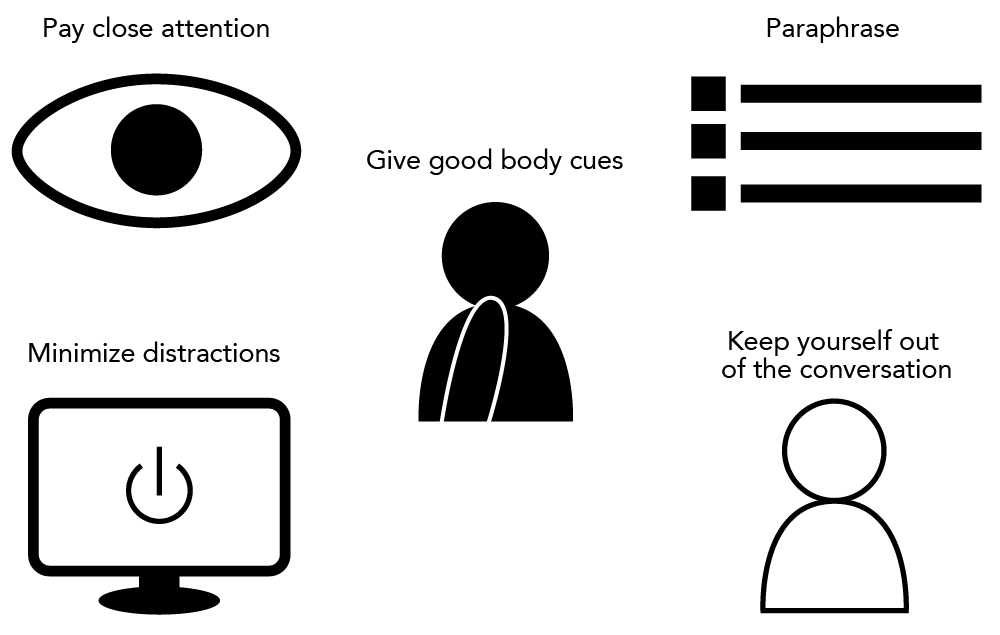1.14: Listening
- Page ID
- 46060
Learning Outcomes
- Discuss the importance of listening
How many times have you wanted to talk about a subject very important to you only to find that the people you’re talking to aren’t really listening? They may look like they’re listening, but they’re really not paying attention at all. Frustrating, isn’t it? How often do you find yourself falling into this same trap, finding that you’re so eager to share your information that you completely stop listening to the person who’s talking?
Communication isn’t just about talking, it’s about listening. In fact, communication only happens when all parties are engaged in uncovering and understanding the meaning behind the words. Otherwise, it’s just a bunch of chatter!
Active Listening
During active listening, listeners give feedback to the speaker, confirming an understanding of what the speaker has said by asking questions and making clarifying statements. Rather than focusing on what they want to say once it’s their turn to speak or allowing themselves to be distracted, they’re reassuring the speaker that they’re interested in the subject matter and want to completely understand the point the speaker is trying to make. It’s the ultimate way of making a fellow participant feel safe in the conversation.

Here are some key skills you should master in order to be an active listener:
- Pay close attention and paraphrase to ensure understanding: If you can step into the conversation by saying, “So let me see if I understand this correctly. What you’re saying is….” then you’re listening hard enough. If you’re saying, “Uh-huh, uh-huh,” but not really recapping a set of statements, then try listening a little harder.
- Ask open ended questions: These questions can encourage the speaker to elaborate on a point, rather than forcing them to say yes or no. This elaboration can also help you understand better what the speaker is trying to communicate.
- Give good body cues: Make eye contact, lean in while the speaker is talking, and don’t let your gaze drift away. If you’re leaning back in a chair reading what’s on your computer monitor, the speaker isn’t going to feel like you’re paying attention even if you are. You can also use body cues to reflect the speaker’s emotions—you don’t have to laugh or cry along, but you can indicate a level of understanding with a facial expression or a nod.
- Minimize distractions: Turn off your radio or push your monitor in another direction in order to pay closer attention to what your guest has to say. When someone is talking to you, do your best to minimize anything that could steal your attention away from the conversation.
- Keep yourself out of the conversation: Avoid sharing how you handled a similar issue, unless you’re specifically asked for advice. Keep an open mind about the subject matter, even if you don’t agree. If someone is complaining about your previous behavior or choices, wait until he or she is done before you launch into a defense. Better yet, don’t launch into a defense. Instead, ask clarifying questions and make sure that you totally understand the other person’s point of view before crafting your response.
Practice question
Those are just a few techniques you can use to become a better listener, but there are also a few ways to ensure that you’re heard. Take those same hints for active listening and turn them around a bit:
- Help your audience by paraphrasing: If no one in your audience is being kind enough to break in to clarify his understanding of your point, then do it for them! Pause mid-point and say, “Let me stop here for a moment. Am I being clear about what I’m trying to say? Is there anything up to this point that you’d like me to go over again?” By posing these questions, you’re encouraging your audience to participate in active listening.
- Minimize things that could be distracting during your conversation: Don’t be afraid to ask your audience to turn off the television for a moment while you make an important point.
- Keep your audience out of the conversation: In much the same way you kept yourself out of the conversation when someone else was talking, don’t invite them to share their own personal stories. It distracts from the point you’re trying to make.
Without listening, there is no understanding. By listening, you can assess your audience’s needs and address them. By ensuring that you’re heard, you can deliver business results.
- Listening. Authored by: Freedom Learning Group. Provided by: Lumen Learning. License: CC BY: Attribution
- Five key skills for active listening image. Provided by: Lumen Learning. License: CC BY: Attribution
- Woman, teamwork image. Authored by: rawpixel. Provided by: Unsplash. Located at: https://unsplash.com/photos/g8bqFDerlLA. License: CC0: No Rights Reserved

